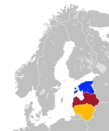This text deals with Low German in the Baltic States, in Estonia, Latvia and Lithuania. The Memel Territory (Memelland) in southwest Lithuania also belongs to this region today, but was part of East Prussia until 1945 and therefore shares its history and not that of the Baltic States.
Low German came to the Baltic States with German merchants, seafarers and conquerors on the Baltic Sea. It is not exactly known when Germans first reached the Baltic region, but the presence of Germans in the Baltics can be traced back to at least the 12th century. The decisive factors here were the colonization by the Brothers of the Sword, the Teutonic Order and the Hanseatic League. Merchants and friars founded cities and the upper class of these cities spoke Low German. Low German also spread to rural areas through German landowners, but was limited to a very small upper class there.
Low German remained the language of the upper classes until the 17th century. After High German had replaced the Hanseatic Middle Low German as a written language, the cities of the Baltic region also adopted High German as their spoken language. This transition took place very rapidly here in comparison with other regions, as there was no rural, Low German-speaking hinterland that could have counteracted this change by keeping the old. When August Wilhelm Hupel published his Idiotikon der deutschen Sprache in Lief- und Ehstland in 1795, he wrote: without even considering some of the peculiar idioms or even inaccuracies that happen, in some houses people can still hear Low German words. At that time, the use of Low German was largely out of use, but apparently not completely forgotten.
Since then, Low German has entirely disappeared in the Baltic States. At least if you disregard the Low German seafarers and boatmen who continued to sail and trade in the Baltic Sea during all this time. However, the language has remained in the form of Low German loanwords that have been adopted into Estonian, Latvian and Lithuanian.
